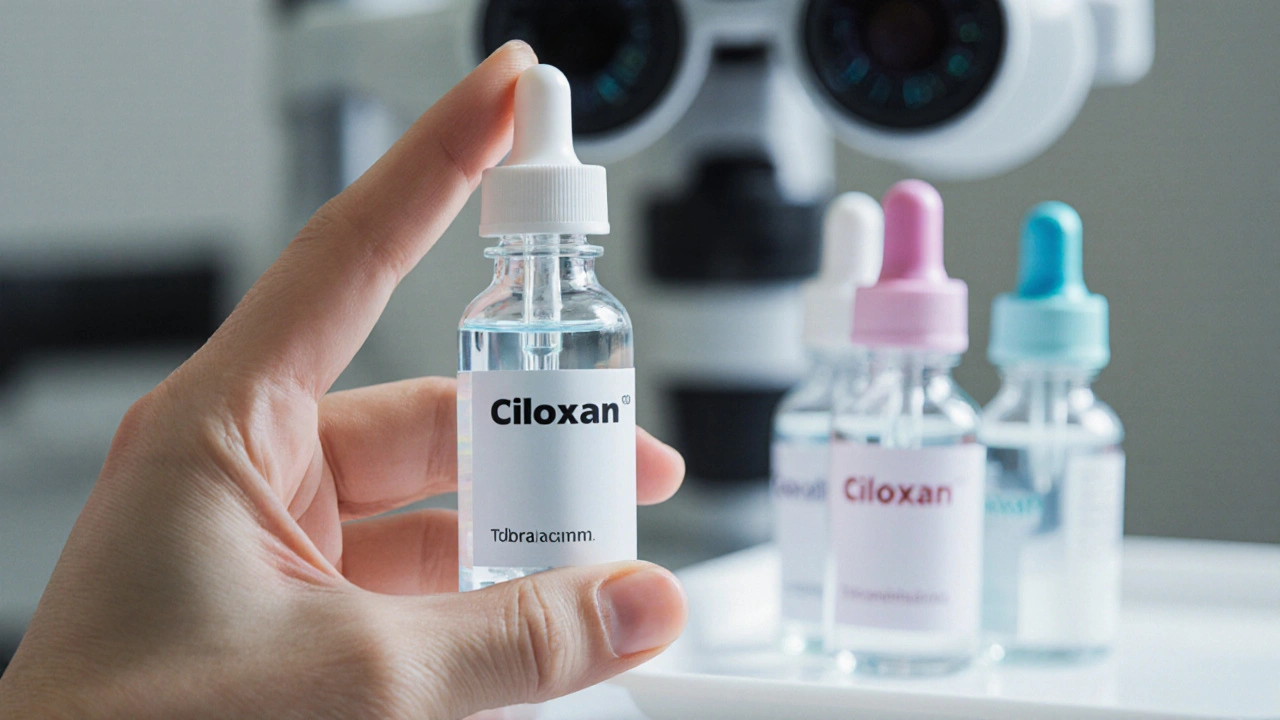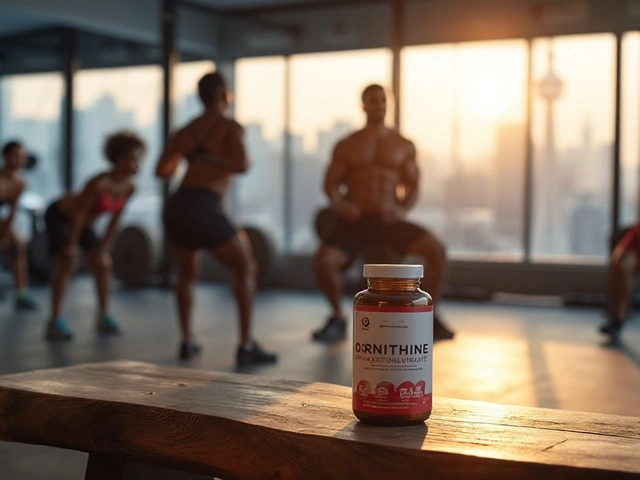
Eye Antibiotic Decision Tool
Choose Your Scenario
Your choices will determine the most appropriate eye antibiotic for your situation.
Key Takeaways
- Ciloxan (0.3% ciprofloxacin) is a fluoroquinolone eye drop used mainly for bacterial conjunctivitis and corneal ulcers.
- Typical alternatives include ofloxacin, levofloxacin, tobramycin, polymyxinB/trimethoprim and chloramphenicol.
- Fluoroquinolones offer broader coverage but carry higher risk of tendon or cartilage toxicity in systemic use; ocular side‑effects remain mild.
- Cost and NHS prescribing guidance often make tobramycin or chloramphenicol the first‑line choices for uncomplicated infections.
- Choosing the right drop depends on infection severity, bacterial resistance patterns, patient allergies and price.
What is Ciloxan?
Ciloxan is a ophthalmic solution containing 0.3% ciprofloxacin hydrochloride, a broad‑spectrum fluoroquinolone antibiotic. It was first approved in the UK in 1994 and is prescribed for bacterial conjunctivitis, keratitis and post‑surgical prophylaxis.
How does Ciprofloxacin work in the eye?
Ciprofloxacin inhibits bacterial DNA gyrase and topoisomerase IV, preventing DNA replication. When applied as drops, it achieves therapeutic concentrations in the tear film and corneal epithelium within minutes, killing Gram‑negative organisms (e.g., Pseudomonas aeruginosa) and many Gram‑positive species (e.g., Staphylococcus aureus).

When is Ciloxan prescribed?
Typical scenarios include:
- Acute bacterial conjunctivitis with purulent discharge.
- Corneal abrasions that become infected.
- Prophylaxis after cataract or refractive surgery.
It is not suitable for viral or allergic conjunctivitis, and clinicians avoid it in patients with known fluoroquinolone allergy.
Common Alternatives
Below are the most frequently used drops that compete with Ciloxan:
- Ofloxacin - another fluoroquinolone (0.3% solution) with similar spectrum.
- Levofloxacin - 0.5% fluoroquinolone, often chosen for its once‑daily dosing.
- Tobramycin - an aminoglycoside (0.3% solution) particularly effective against Pseudomonas.
- PolymyxinB/Trimethoprim - a combination (0.1%/0.025%) offering broad coverage with good safety.
- Chloramphenicol - a phenicol (0.5% ophthalmic ointment or drops) used when cost is a priority.
Side‑Effect Profile
All topical antibiotics can cause mild irritation, transient redness, or a burning sensation. Specific concerns:
- Ciloxan: Rare corneal epithelial toxicity, occasional allergic contact dermatitis.
- Ofloxacin & Levofloxacin: Similar irritation rates; systemic fluoroquinolone warnings do not apply to eye drops.
- Tobramycin: Possible ototoxicity is irrelevant ocularly, but can cause more pronounced stinging.
- PolymyxinB/Trimethoprim: Low irritation, but rare hypersensitivity.
- Chloramphenicol: Risk of rare bone marrow suppression with prolonged use; widely avoided in children.
Cost and Availability (2025 UK Context)
Based on NHS reference pricing and typical private pharmacy lists:
- Ciloxan (10ml): £4.80 (NHS prescription), £7.20 private.
- Ofloxacin (10ml): £5.10 NHS, £7.80 private.
- Levofloxacin (10ml): £5.60 NHS, £8.50 private.
- Tobramycin (10ml): £3.20 NHS, £5.00 private.
- PolymyxinB/Trimethoprim (10ml): £2.80 NHS, £4.60 private.
- Chloramphenicol (5ml ointment): £1.70 NHS, £3.00 private.
These figures show that cheaper options exist for uncomplicated infections, while fluoroquinolones remain the premium choice for resistant or severe cases.

Comparison Table
| Drug | Class | Concentration | Typical Dosing | Coverage (Gram‑) | Cost (NHS) | Common Side‑Effects |
|---|---|---|---|---|---|---|
| Ciloxan | Fluoroquinolone | 0.3% | 1drop QID for 7days | Broad (Gram‑, Gram+) | £4.80 | Irritation, rare dermatitis |
| Ofloxacin | Fluoroquinolone | 0.3% | 1drop QID or BID for 7days | Broad (similar to ciprofloxacin) | £5.10 | Irritation, photosensitivity |
| Levofloxacin | Fluoroquinolone | 0.5% | 1drop BID for 5days | Broad, excellent against Pseudomonas | £5.60 | Mild stinging, rare corneal haze |
| Tobramycin | Aminoglycoside | 0.3% | 1drop QID for 7days | Strong Gram‑, limited Gram+ | £3.20 | Stinging, rare epithelial toxicity |
| PolymyxinB/Trimethoprim | PolymyxinB + Trimethoprim | 0.1% / 0.025% | 1drop QID for 5‑7days | Broad (incl. Pseudomonas) | £2.80 | Minimal irritation, rare allergy |
| Chloramphenicol | Phenicol | 0.5% (ointment) or 0.5% drops | 1‑2drops TID for 7days | Gram‑+, limited Gram‑ | £1.70 | Rare bone‑marrow suppression (long‑term) |
How to Choose the Right Eye Antibiotic
Think of the decision like a checklist. Start with infection severity, then move to bacterial profile, patient tolerance, and finally cost.
- Severity: For mild conjunctivitis, cheap options (chloramphenicol or polymyxinB/trimethoprim) are usually enough.
- Resistance risk: If the doctor suspects Pseudomonas or a resistant strain, a fluoroquinolone (Ciloxan, levofloxacin) is safer.
- Allergy history: Avoid fluoroquinolones if the patient reports previous reactions; switch to tobramycin or polymyxinB.
- Cost considerations: NHS prescriptions make the price gap smaller, but private patients often prefer the cheapest effective drop.
- Compliance: Once‑daily regimens (levofloxacin) improve adherence, especially for elderly patients.
When in doubt, the UK NICE guideline (NG90) recommends starting with a narrow‑spectrum agent and escalating only after culture results.
Practical Tips & Common Pitfalls
- Always wash hands before instilling drops to avoid contaminating the bottle.
- Do not touch the tip of the bottle to the eye or eyelid; this can introduce bacteria and shorten shelf life.
- If the dropper number is unclear, count the drops-most 10ml bottles deliver ~200 drops.
- For patients using multiple eye drops, space the applications by at least 5minutes to prevent dilution.
- Watch for worsening redness or pain after 48hours; this may signal resistance or a non‑bacterial cause requiring a different therapy.
Frequently Asked Questions
Can I use Ciloxan for viral conjunctivitis?
No. Viral conjunctivitis, usually caused by adenovirus, does not respond to antibiotics. Supportive care-artificial tears and cold compresses-is the standard treatment.
Is there a risk of systemic side‑effects from eye drops?
Systemic exposure from topical eye drops is minimal. The serious tendon or cartilage warnings linked to oral fluoroquinolones are not relevant for Ciloxan.
How long should I keep the bottle after opening?
Once opened, most NHS‑supplied eye drop bottles are good for 28days if stored at room temperature and the tip remains uncontaminated.
Can I use Ciloxan together with steroid eye drops?
Yes, but only under a doctor’s supervision. The antibiotic should start a few minutes before the steroid to ensure adequate bacterial coverage.
Which alternative is best for a patient allergic to fluoroquinolones?
Tobramycin or polymyxinB/trimethoprim are safe choices; they belong to different antibiotic classes and have low cross‑reactivity.
Write a comment
Your email address will not be published.






6 Comments
Ciloxan’s broad‑spectrum coverage makes it a solid choice for moderate eye infections.
Reading through the comparison, I’m reminded how nuanced eye‑drop selection can be. The cost differences are striking, especially when NHS prescribing squeezes cheaper options to the forefront. Yet, the pharmacodynamics of fluoroquinolones justify their premium price in resistant cases. Ultimately, matching the drug to the patient’s allergy profile feels like the safest path.
Even a mild conjunctivitis benefits from a targeted drop. Polymyxin‑B/Trimethoprim often does the trick without breaking the bank.
I love how the tool breaks down severity and cost all in one place :)
Super handy for quick decisions.
Ciloxan’s efficacy is clear, but you shouldn’t overlook tobramycin when Pseudomonas is suspected. The cost gap can be decisive for NHS patients. Always verify the allergy history before prescribing.
Nice layout, the table is easy to scan.
Helps me explain options to my mom.